Study on Compaction Characteristics and Compaction Process of an Unsaturated Silt Based on PFC3D
Abstract
1. Introduction
2. Analysis of the Contact Effect between Particles of an Unsaturated Silt
3. Discrete Element Simulation of an Unsaturated Silt Static Triaxial Test
3.1. Modeling
3.2. Calibration of Microscopic Parameters
3.3. Rationality Verification of Discrete Element Simulation
4. Research on the Rolling Compaction Process
4.1. Modeling
4.2. Loads Infliction
4.3. Analysis of the Compaction Results
4.3.1. Relationship between the Compaction Effect and Rolling Times
4.3.2. Analysis of the Relationship between the Compaction Effect and the Rolling Process
4.4. On-Site Compaction Process Analysis
5. Conclusions
- (1)
- This article relates matrix suction to water content and uses matrix suction to approximate the water content state of soil samples. By comparing the results of the discrete element simulation triaxial compression test with the indoor triaxial compression test, the microscopic parameters of the unsaturated soil model were calibrated, and the accuracy of using matrix suction to characterize the water content state was verified. The feasibility of using Hill contact simulation of unsaturated soil was also confirmed.
- (2)
- During the simulation of the rolling process using the PFC3D software, it was found that the relationship between the number of static rolling and the degree of compaction is proportional. The change in compaction degree in the whole rolling process can be divided into two stages: the first stage is the initial rolling stage, and the compaction degree of the model increases rapidly in this stage. The second stage is the re-grinding stage. The particles are relatively stable, and the increase in compaction degree is not significant. The reasonable rolling times are preliminarily determined to be five times, according to discrete element simulation.
- (3)
- Through PFC3D software simulation, the changes in compaction degree under different rolling process combinations under the optimal moisture content conditions were analyzed. The results showed that compared with static compaction, both strong and weak vibration compaction can significantly improve the compaction effect of the roadbed compaction model. The larger the amplitude of the roller vibration, the more obvious the improvement of this compaction effect. For the combination of strong vibration and weak vibration compaction, the compaction effect of strong vibration followed by weak vibration is stronger than that of weak vibration followed by strong vibration.
- (4)
- Taking the unsaturated silt roadbed of the Dezhou-Qihe section of the Jingtai Expressway as the research object, the rolling test of a cement-modified unsaturated silt roadbed under the optimum moisture content was carried out using a field test to determine the optimum rolling compaction combination under this moisture content. According to the field test data, it can be seen that when the water content is 15%, the best compaction combination is static rolling once + strong vibration twice + weak vibration twice, which is consistent with the discrete element simulation results and has a certain guiding role in the construction of the project site.
Author Contributions
Funding
Institutional Review Board Statement
Informed Consent Statement
Data Availability Statement
Conflicts of Interest
References
- Ma, H.J. Elementary discussion on disposal method of subgrade filling over-wet soil. Urban Roads Bridg. Flood Control 2014, 184, 35–36. [Google Scholar] [CrossRef]
- Xu, X. The strength and deformation characteristics of unsaturated soil at high suction and low stress. Doctor’s Thesis, Beijing Jiaotong University, Beijing, China, 2019. [Google Scholar]
- Shi, J.G.; Shao, S.J.; Tao, H.; Xu, P. True triaxial tests and strength deformation behaviors of unsaturated soils. Chin. J. Geotech. Eng. 2011, 33, 92–97. [Google Scholar]
- Ye, L.M. Study on Engineering Characteristics of Unsaturated Silt Subgrade in Drying and Wetting Cycle. Master’s Thesis, Zhengzhou University, Zhengzhou, China, 2014. [Google Scholar]
- Chen, Z.H.; Guo, N. New developments of mechanics and application for unsaturated soils and special soils. Rock. Soil. Mech. 2019, 40, 1–54. [Google Scholar] [CrossRef]
- Guo, Y.; Chi, S.C.; Mi, X.F. Experimental study on particle strength and elastic mechanical parameters of coarse-grained soil. Chin. J. Geotech. Eng. 2021, 43, 1675–1681. [Google Scholar] [CrossRef]
- Kuhn, M.R.; Suzuki, K.; Daouadji, A. Linear-frictional contact model for 3D discrete element simulations of granular systems. Int. J. Numer. Meth. Eng. 2020, 121, 560–569. [Google Scholar] [CrossRef]
- Kuhn, M.R.; Daouadji, A. Simulation of undrained quasi-saturated soil with pore pressure measurements using a discrete element (DEM) algorithm. Soils Found. 2020, 60, 1097–1111. [Google Scholar] [CrossRef]
- Liu, S.H.; Sun, D.A.; Wang, Y. Numerical study of soil collapse behavior by discrete element modelling. Comput. Geotech. 2003, 30, 399–408. [Google Scholar] [CrossRef]
- Liu, S.P. Three Dimensional Liquid Bridge Contact Model and Discrete Element Numerical Simulation Study of Unsaturated Soil. Master’s Thesis, Beijing Jiaotong University, Beijing, China, 2019. [Google Scholar] [CrossRef]
- Zhou, F.X.; Zhao, M.; Ying, S. Analysis of mechanical behavior for unsaturated soil by three-dimensional discrete element method. J. Fuzhou Univ. (Nat. Sci. Ed.) 2020, 48, 779–785. [Google Scholar]
- Zhang, N. Three-Dimensional Numerical Analysis of the Compaction Properties of RCC Based on DEM. Master’s Thesis, Zhejiang University, Hangzhou, China, 2015. [Google Scholar]
- Yan, X.; Feng, Z.C.; Huang, G.Q. Research on construction technology of low liquid limit powder roadbed for highway. Highway Transp. Technol. (Appl. Technol. Ed.) 2019, 15, 47–49. [Google Scholar]
- Cai, L. Analysis of construction technology of low liquid limit powder roadbed. Highway Transp. Technol. (Appl. Technol. Ed.) 2020, 16, 63–65. [Google Scholar]
- Potyondy, D. Material-Modeling Support in PFC [fistPkg25]; Technical Memo; Itasca Consulting Group: Minneapolis, MN, USA, 2017; ICG7766-L. [Google Scholar]
- Cundall, P.A. Computer simulations of dense sphere assemblies. Stud. Appl. Mech. 1988, 20, 113–123. [Google Scholar] [CrossRef]
- Potyondy, D.O. The Bonded-Particle Model as a Tool for Rock Mechanics Research and Application: Current Trends and Future Directions. Geosyst. Eng. 2015, 18, 1–28. [Google Scholar] [CrossRef]
- Xu, K.; Huang, W.X.; Huang, L.Y. Numerical simulation and analysis of roller compaction of granular soil. Yellow River 2014, 36, 124–127. [Google Scholar]


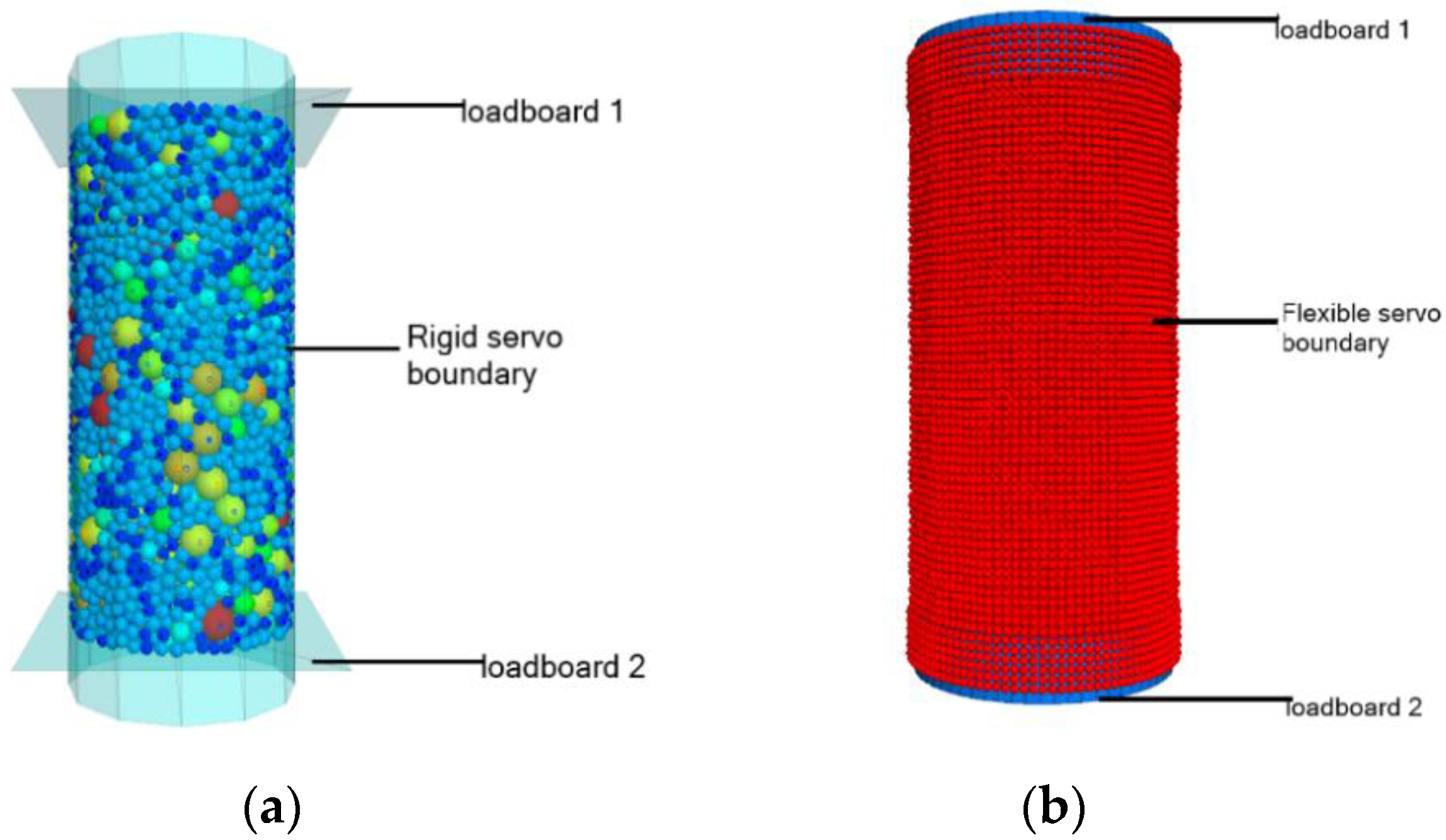
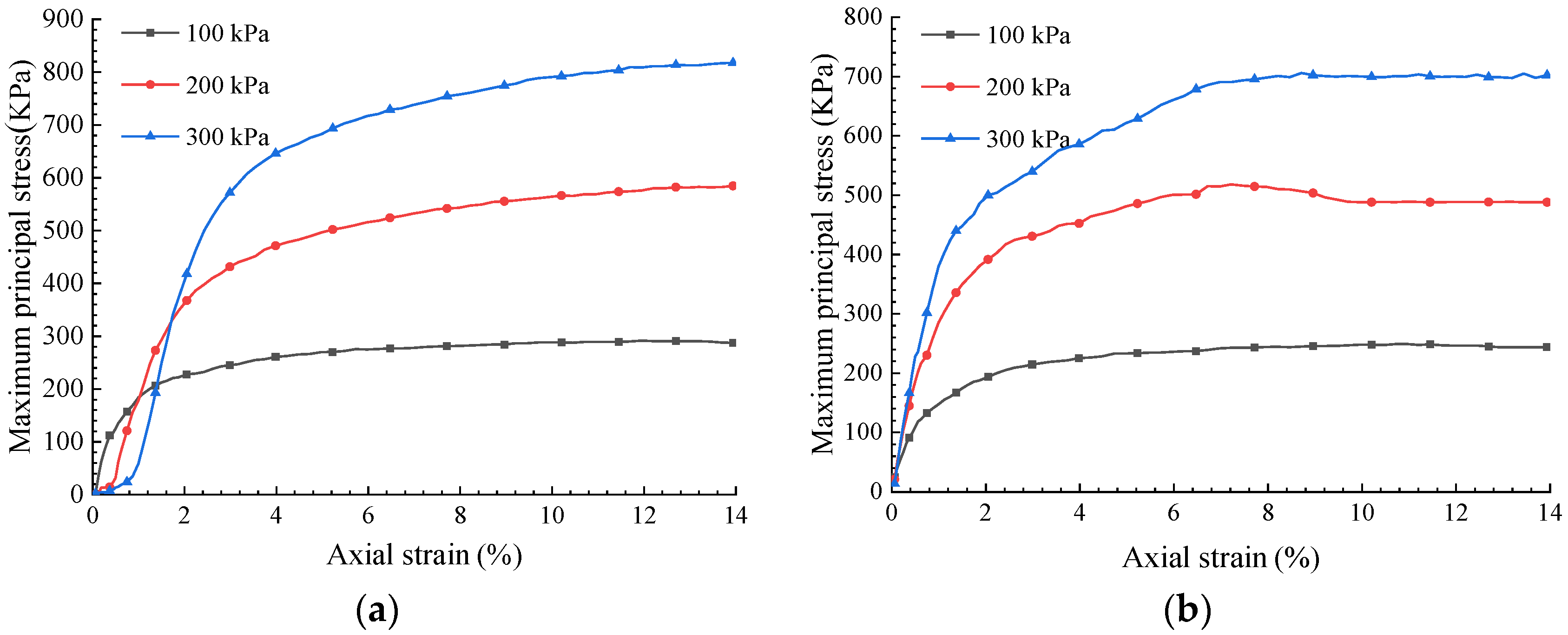


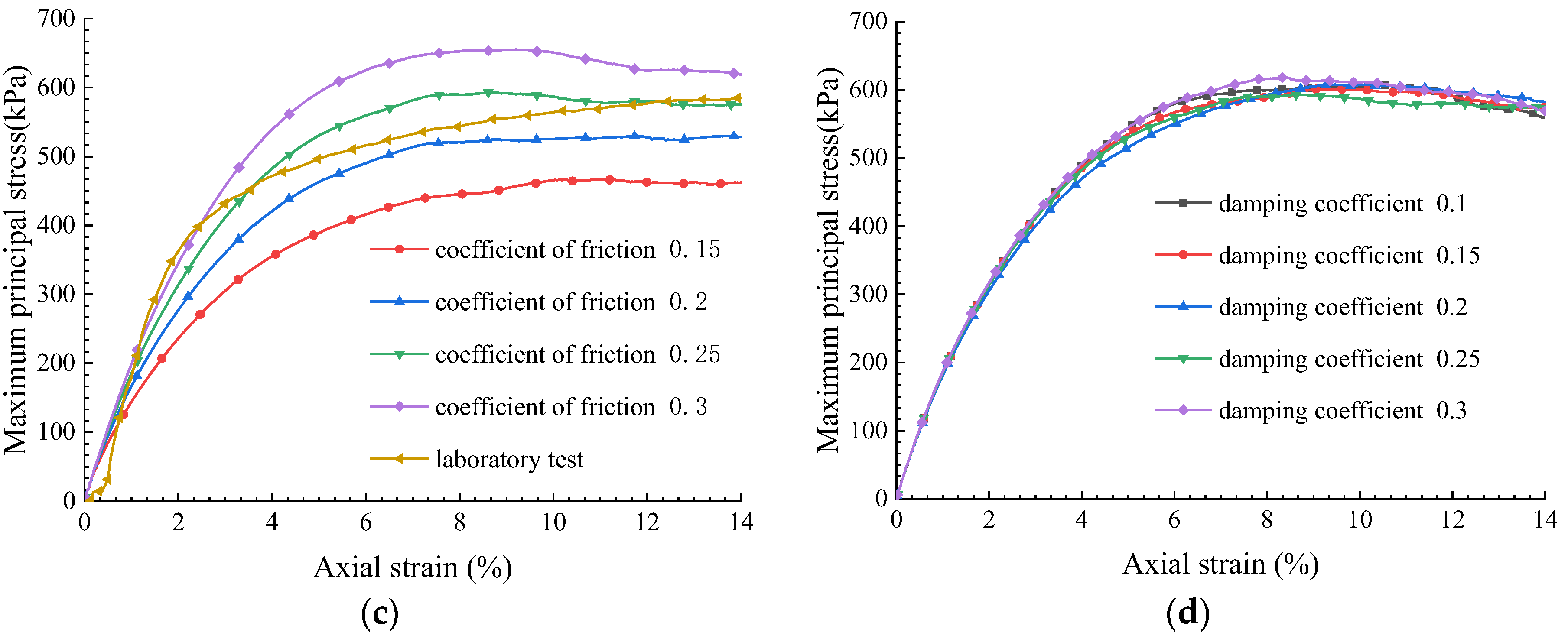
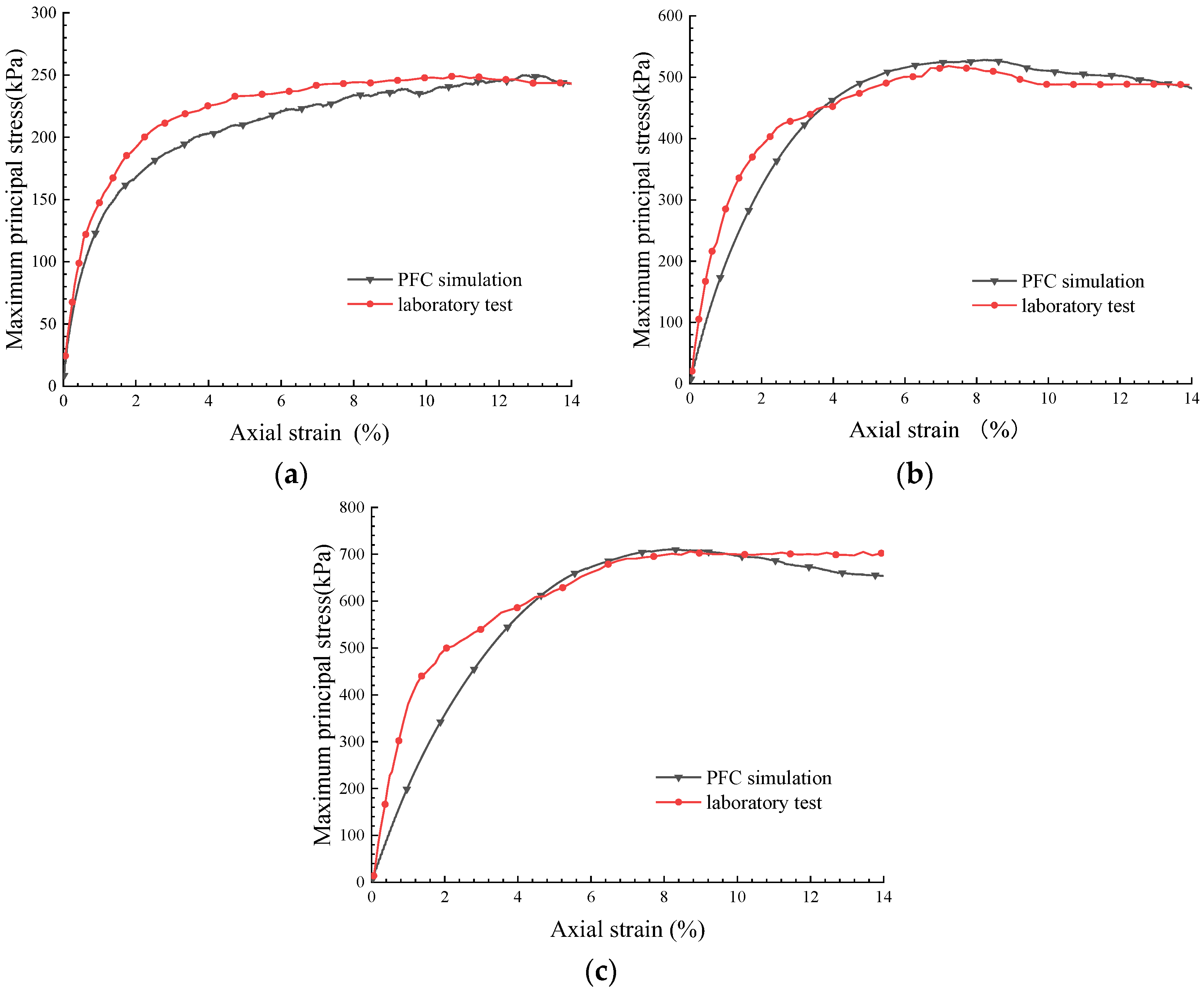


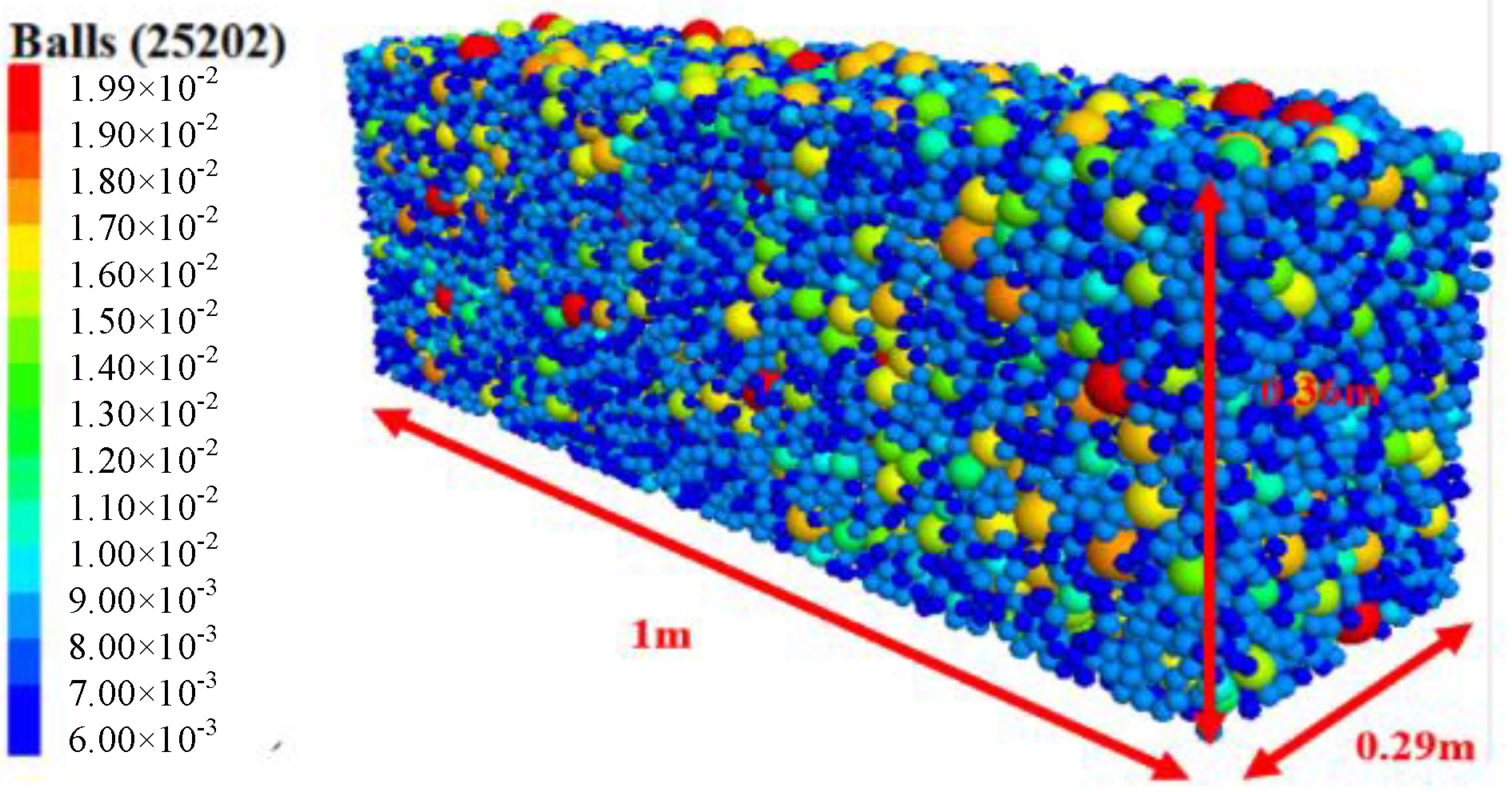
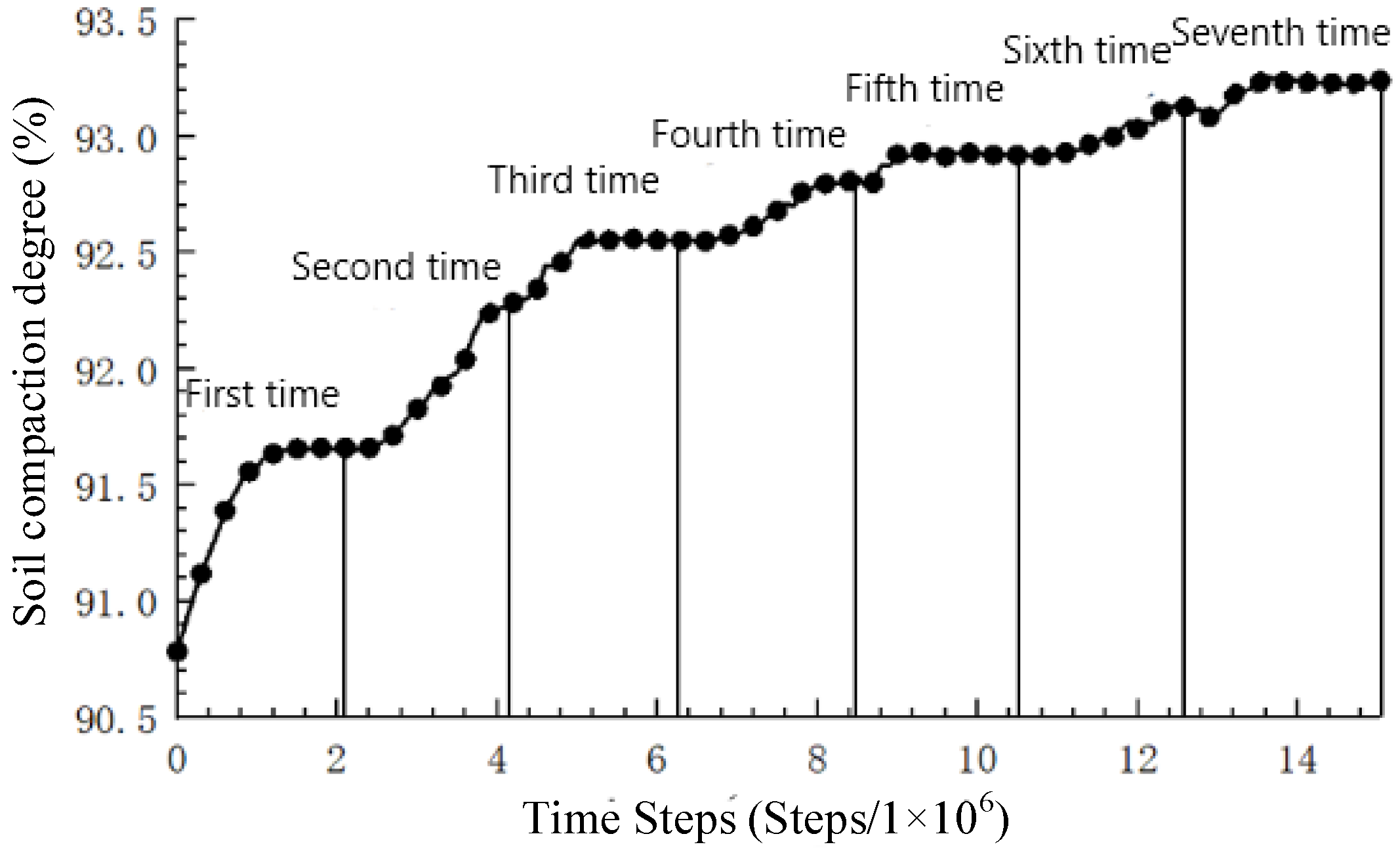
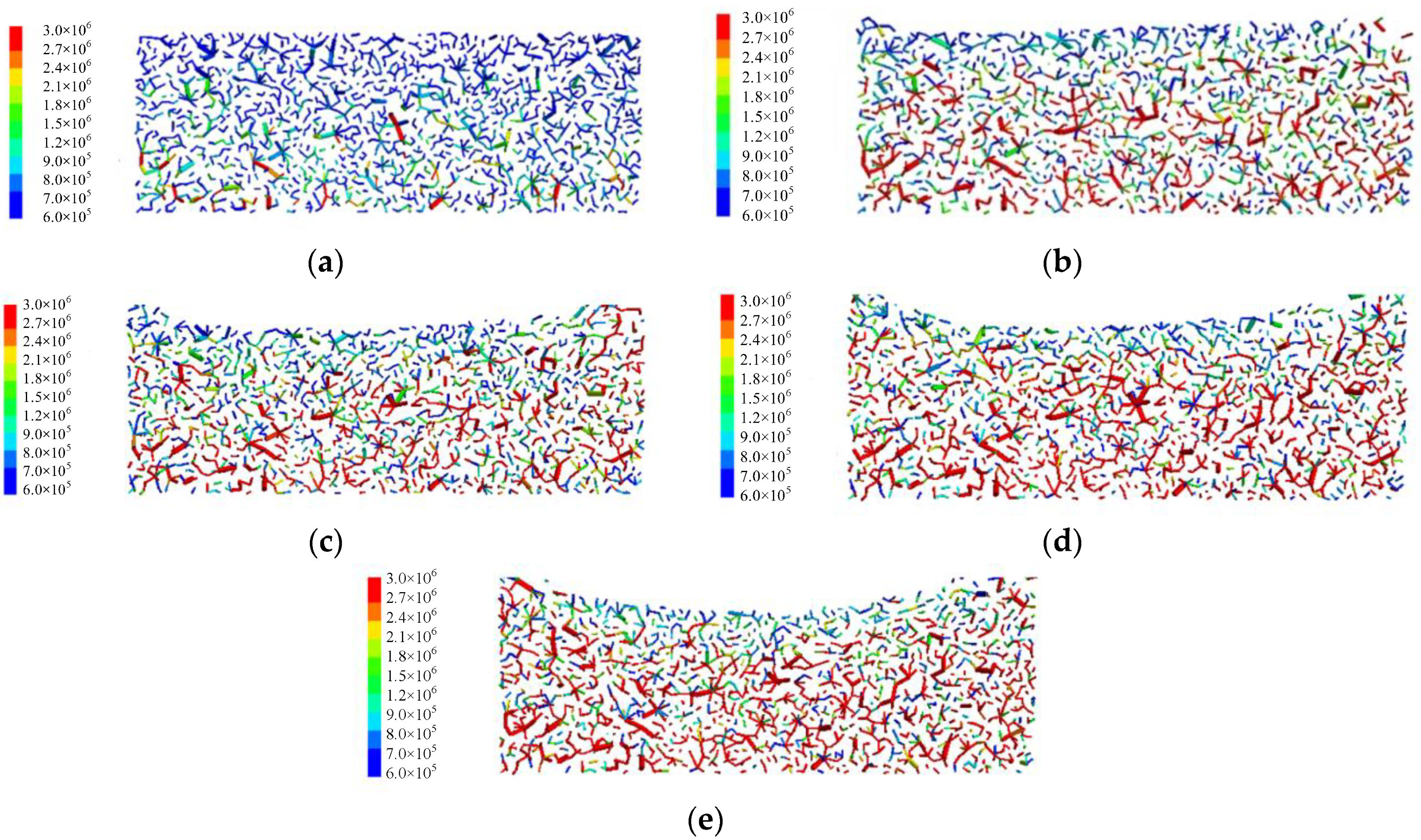

| Particle Diameter/mm | Relative Density of Particles | Liquid Limit/% | Plastic Limit/% | Plasticity Index/Ip | Soil Properties |
|---|---|---|---|---|---|
| 0.002–2 | 2.70 | 32.3 | 23.6 | 8.7 | low liquid limit silt |
| Contact Stiffness/Pa | Suction/KPa | Damping Coefficient | Friction Coefficient |
|---|---|---|---|
| 2.5 × 108 | 130 | 0.25 | 0.25 |
| Grinding Wheel Weight/N | Exciting Force/N | Vibration Frequency/Hz | The Gait of March/m*·s−1 |
|---|---|---|---|
| 505 | 928 | 30 | 0.1 |
| Rolling Times | Contact Force Chain Size/N |
|---|---|
| 0 | 2.52 × 105 |
| 1 | 6.84 × 105 |
| 2 | 1.06 × 106 |
| 3 | 1.35 × 106 |
| 4 | 1.74 × 106 |
| 5 | 1.98 × 106 |
| 6 | 2.14 × 106 |
| 7 | 2.23 × 106 |
| Compaction Combination | Degree of Compression |
|---|---|
| Static rolling 1 time + Weak vibration 2 times | 90.8% |
| Static rolling 1 time + Weak vibration 3 times | 92.2% |
| Static rolling 1 time + Weak vibration 4 times | 94.6% |
| Static rolling 1 time + Weak vibration 5 times | 95.3% |
| Static rolling 1 time + Strong vibration 3 times | 93.2% |
| Static rolling 1 time + Strong vibration 4 times | 96.4% |
| Static rolling 1 time + Strong vibration 5 times | 94.3% |
| Static rolling 1 time + Weak vibration 2 times + Strong vibration 2 times | 96.6% |
| Static rolling 1 time + Strong vibration 2 times + Weak vibration 2 times | 98.1% |
Disclaimer/Publisher’s Note: The statements, opinions and data contained in all publications are solely those of the individual author(s) and contributor(s) and not of MDPI and/or the editor(s). MDPI and/or the editor(s) disclaim responsibility for any injury to people or property resulting from any ideas, methods, instructions or products referred to in the content. |
© 2023 by the authors. Licensee MDPI, Basel, Switzerland. This article is an open access article distributed under the terms and conditions of the Creative Commons Attribution (CC BY) license (https://creativecommons.org/licenses/by/4.0/).
Share and Cite
Ma, Z.; Lu, K.; Song, D.; Liu, W.; Wang, Y.; Li, S. Study on Compaction Characteristics and Compaction Process of an Unsaturated Silt Based on PFC3D. Appl. Sci. 2023, 13, 5547. https://doi.org/10.3390/app13095547
Ma Z, Lu K, Song D, Liu W, Wang Y, Li S. Study on Compaction Characteristics and Compaction Process of an Unsaturated Silt Based on PFC3D. Applied Sciences. 2023; 13(9):5547. https://doi.org/10.3390/app13095547
Chicago/Turabian StyleMa, Zhitao, Keyu Lu, Daifu Song, Wenhu Liu, Yipeng Wang, and Shunhai Li. 2023. "Study on Compaction Characteristics and Compaction Process of an Unsaturated Silt Based on PFC3D" Applied Sciences 13, no. 9: 5547. https://doi.org/10.3390/app13095547
APA StyleMa, Z., Lu, K., Song, D., Liu, W., Wang, Y., & Li, S. (2023). Study on Compaction Characteristics and Compaction Process of an Unsaturated Silt Based on PFC3D. Applied Sciences, 13(9), 5547. https://doi.org/10.3390/app13095547





